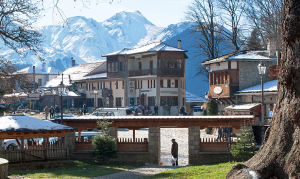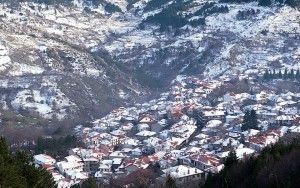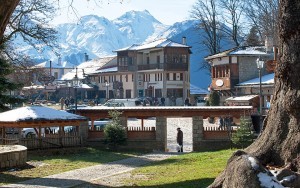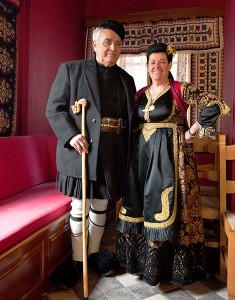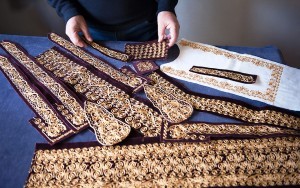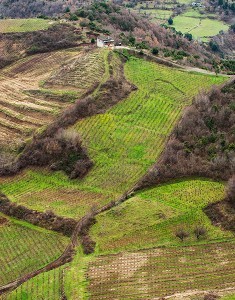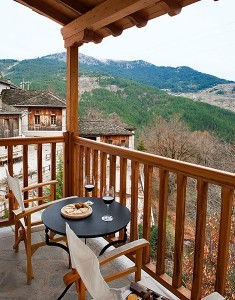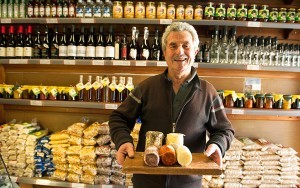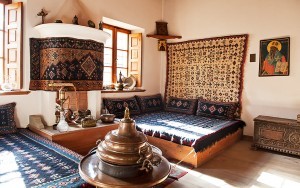Metsovo, a mountain village in the Pindos area, northwestern Greece is a model of development with robust wine and culture-based tourism. Even though the the year’s average temperature does not exceed 10° C, this charming destination remains lively all year round thanks to the devotion of its people and the generosity of benefactors, who have helped maintain the local culture and capitalize on the natural beauty.
The past struggles of daily life in this mountain village have made their way into local stories, songs, dances and crafts, and can be sensed today. The main square still echoes Metsovo’s age-old history. There, elderly men sit chatting in Vlach, a dialect that is still understood by the young, but used less and less these days. It is a relic of this small village’s long history.
Other traditions are still just about alive in Metsovo. The wall of a store run by Evaggelos Balabekos, a long-serving tailor of traditional garments, are adorned with a number of unique pieces that highlight the region’s heritage, including a stunning gold embroidered vest – a real museum piece. This tailoring tradition is now facing extinction in Metsovo as fewer young people are willing to commit themselves to unpaid apprenticeships, as was the rule during the tailor’s heyday. “This art is learnt between the ages of 12 and 16. Any time after that is too late. I learnt my trade practicing 10 to 12 hours a day when I was 12 years old, without pay,” Balabekos explained. “These days, everybody wants to be paid from day one.”
Due to its strategic position, Metsovo served as a crucial military corridor during Ottoman times, offering its forces safe passage from Epirus to the regions of Thessaly, Macedonia, Constantinople and vice versa. This strategic position lured Ottoman support, generating early economic growth and social prosperity.
A storage facility for woven fabrics, silverware and gold was developed in the early 18th century, establishing Metsovo as a prominent manufacturing and trading center. Trade flourished and reputable stores were opened at major commercial centers of the period – Venice, Naples, Trieste, Marseille, Vienna, Moscow, Odessa and Constantinople.
Today, farming, logging, cheese production and – especially – tourism are the main industries of the area. But this wouldn’t have been the case without Evangelos Averoff, an influential 20th century politician who headed various ministries. He was the one who sought funds to support his family’s homeland, after noticing the area’s post-war decline. Over the next 10 years, Averoff tried to convince the Baron Michael Tositsas, a rich heir who lived alone in Switzerland, to not forsake his homeland. The eventual establishment of a foundation in 1947 to support and develop the region had an immense impact.
It was through this foundation that several important developments took place in Metsovo. The funds helped create a folklore museum, primary school, hospital, timber factory, creamery, ski resort and a dairy farm with cows brought over from Switzerland. Old buildings, churches and monasteries were preserved, water taps, cobbled paths and a drainage system were developed, roads were lit, three million trees were planted, 150 schools opened throughout the Epirus region and an accommodation unit for university students from Epirus was constructed in Athens.
The other effect of this mammoth effort was the establishment of the local tourism industry, spearheaded by the Katogi Averoff Hotel & Winery. “We were the first venture in Greece to offer a full wine tourism experience,” said Sotiris Ioannou, the hotel and winery’s founder, and Evangelos Averoff’ son in law. A member of Aria Hotels, The Katogi Averoff organizes wine and gastronomic experiences, supported by Trip2Taste, a company promoting quality Greek gastronomy. Visitors should definitely try Katogi’s wines, including the award-winning Inima Negoska and Flogero, aged for 12 months in oak barrels.
A visit to the Folklore Museum is also a must. The three-level building, formerly a mansion belonging to the family of Tositsas, was restored in 1954 and offers a detailed presentation of the daily life in Metsovo over the centuries. A rich collection of items, including woven fabrics, bridal jewelry, costumes, rare books and famed Ioannina silverware are on display.
Source: greece-is.com
Ask me anything
Explore related questions
